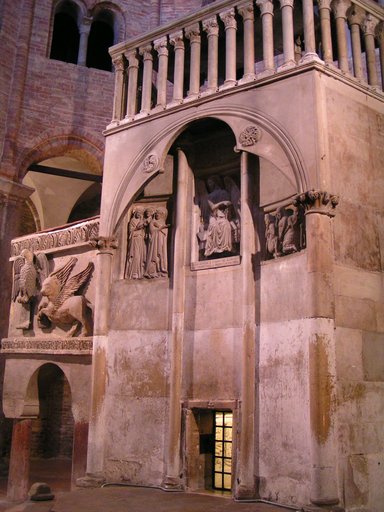St. Petronius

Early 16th Century Italian statue of St. Petronius at the Joslyn Art Museum in Omaha, Nebraska. He is represented holding the city of Bologna, of which he is the patron Saint of and at the bottom is written in Latin, “Pray for us sinners.”
Bishop of Bologna, date of birth unknown; died before 450. The only certain historical information we possess concerning him is derived from a letter written by Bishop Eucherius of Lyons (died 450-5) to Valerianus (in P. L., L, 711 sqq.) and from Gennadius’ “De viris illustribus”, XLI (ed. Czapla, Münster, 1898, p. 94). Eucherius writes that the holy Bishop Petronius was then renowned in Italy for his virtues. From Gennadius we receive more detailed information: Petronius belonged to a noble family whose members occupied high positions at the imperial Court at Milan and in the provincial administrations at the end of the fourth and the beginning of the fifth centuries. His father (also named Petronius) was probably prœfectus prœtorio, since a Petronius filled this office in Gaul in 402-8. Eucherius seems to suggest (P. L., L, 719) that the future bishop also held an important secular position.
Even in his youth Petronius devoted himself to the practices of asceticism, and seems to have visited the Holy Places in Jerusalem, perhaps on a pilgrimage. About 432 he was elected and consecrated Bishop of Bologna, where he erected a church to St. Stephen, the building scheme of which was in imitation of the shrines on Golgotha and over the Holy Sepulchre in Jerusalem. The buildings belong approximately to the period when Leo I had basilicas erected in Rome and Galla Placidia in Ravenna. Petronius is believed to have written a work on the life of the Egyptian monks (Vitæ patrum Ægypti monachorum); the author of this work, however, is Rufinus of Aquileia. The treatise “De ordinatione episcopi”, bearing the name of Petronius as author, is by the elder Petronius, who was a man of eloquence and wide acquaintance with the secular sciences. Morin has published a sermon entitled “In die ordinationis vel Natale episcopi” (Revue bénédictine, 1897, 3 sq.), which Gennadius ascribes to Bishop Petronius of Verona, whom Czalpa holds is Petronius of Bologna, but this assignment is not certain.

The 14th century pulpit, within the church called “Basilica del Santo Sepolcro”, built above the grave of St. Petronius. According to tradition St. Petronius built the Basilica over a temple of the goddess Isis. The saint wished to have a building that recalled the Church of the Holy Sepulchre in Jerusalem.
According to Gennadius, Petronius died during the reign of Emperor Theodosius and Valentinian, i. e., before 450. In the twelfth century appeared a legendary life of the saint, whose relics were discovered in 1141. Shortly afterwards a church was erected in his honour at Bologna; a second, planned on a large seal, was begun in 1390, and built as far as the cross-aisle. In 1659 the building was resumed and the glorious Italian-Gothic church completed as it stands to-day. The feast of St. Petronius is celebrated on 4 October.
Acta SS., II, Oct., 454 sqq.; MELLONI, Atti o memorie di S. Petronio (Bologna, 1784); BOLLAND, Bibl. hag. lat., II (1901), 965-6; MORIN, Deux petits discours d’un évêque Petronius du Ve. siècle in Revue bénédictine (1897), 1 sqq.; CZAPLA, Gennadius als Literarhistoriker (Münster, 1898), 94 sqq.; LANZONI, San Petronio, vescovo di Bologna nella storia e nella legenda (Rome, 1907)
J. P. KIRSCH (Catholic Encyclopedia)






